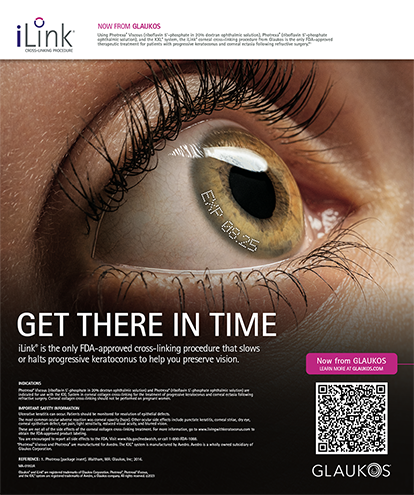
Foreword
The Oracle Vision Council is a small and diverse group of driven, millennial ophthalmologists who are immersed in innovation and dedicated to furthering our field through discovery and early adoption of future vision technologies. We are highly motivated to make significant contributions to ophthalmology early in our careers, and our membership is already heavily involved with research and education while also holding leadership roles across the ophthalmic industry and within academic institutions.
In olden times, the oracle was a person or council one would visit when seeking knowledge. The members of the Oracle Vision Council are futurists, using our combined experience and that of our mentors to try to predict trends that will shape our field. Given our mission, which is to enrich the quality of life of our patients through catalyzing future vision technologies, we have offered the editors of CRST our services to survey selected ophthalmic meetings each year and submit reports on the trends and upcoming technologies that we have spotted at these meetings. This is the first such report, written by one of our members, O. Bennett Walton, IV, MD, MBA. Future reports will be written by other members. A list of our current membership is on the following page of this article.
We hope you enjoy reading this and our future submissions, and we look forward to keeping the readers of CRST up to date on the cutting edge of ophthalmology, as seen through our eyes.
BLAKE K. WILLIAMSON, MD, MPH, MS | THE ORACLE VISION COUNCIL

The 2019 ASCRS•ASOA Annual Meeting in San Diego, and the Ophthalmology Innovation Summit held in conjunction with it, once again emphasized the rapid pace of development of new ideas and technologies in the cataract and refractive surgery landscape. The pharmaceutical discussion this year was less about new molecules and more about new methods of delivery.
In the continued trend toward intracameral antibiotic administration, Tal Raviv, MD, was voted the winner of the ASCRS competition The Voice of Ophthalmology, with his argument for intracameral antibiotics as the best endophthalmitis prophylaxis.1
NEW DELIVERY METHODS
In the realm of perioperative steroids, the winner of the current innovation cycle is the familiar steroid molecule dexamethasone. Two new routes of administration for this drug, geared toward postcataract surgery recovery, were approved by the FDA this past year: Dextenza (dexamethasone ophthalmic insert 0.4 mg, Ocular Therapeutix), a self-resorbing intracanalicular insert, and Dexycu (dexamethasone intraocular suspension 9%, EyePoint Pharmaceuticals), an intracameral self-tapering injection.
Both products were designed to ease the postoperative drop burden on patients and avoid risks associated with nonadherence. With Dextenza, the entire implant resorbs into the canaliculus without the need to remove anything later. Dexycu, which is designed for placement in the ciliary sulcus, is engineered with characteristics that prompt it to form a sphere within aqueous. As it dissolves, it shrinks into a progressively smaller sphere, which reduces surface area (A = 4π r2) and slows the dissolution rate. As such, it effectively self-tapers before disappearing completely.
MORE IN THE PIPELINE
This trend of focusing on drug delivery methods is likely to extend beyond the perioperative period. Products still in clinical trials for regulatory approval include ones from Glaukos, Mati Therapeutics, Allergan, and Eyenovia.
Glaukos. The iDose Travoprost, which is placed in the angle similar to an iStent inject (Glaukos), is designed to release travoprost for an extended time (6 to 12 months) before being removed and replaced with a new iDose implant.
Mati Therapeutics. This company is developing an intracanalicular drug delivery device containing a drug reservoir. Unlike Dextenza, it will not self-resorb, and it is designed for longer-term use. Mati anticipates excellent retention of its plug, with studies so far demonstrating 92% to 96% plug retention at 12 weeks.2 The company anticipates that this delivery technology could be paired with a number of ophthalmic topical medications. One potential advantage of the Mati device is that the drug contents are in a compartment exposed only to the eye, prioritizing exposure to the ocular surface and not the downstream nasolacrimal mucosa.
Allergan. Bimatoprost SR is a biodegradable anterior chamber implant that dispenses the IOP-lowering drug over an extended period. It has been evaluated in two completed phase 3 clinical trials. Allergan anticipates that the product will be placed during an in-office procedure similar to the procedures used by our retina colleagues to insert Iluvien (fluocinolone acetonide intravitreal implant 0.19 mg, Alimera Sciences) or Ozurdex (dexamethasone intravitreal implant 0.7 mg, Allergan). It is not fixed in the angle like iDose, but rather rests in the inferior angle until it dissolves. Allergan is also continuing development of a bimatoprost ring—think of a small, flexible symblepharon ring—designed to be replaced every 3 to 6 months.
Eyenovia. This company takes a different approach with its MicroProst prostaglandin spray, now in phase 3 clinical trials. This delivery method exposes only 6 to 8 µL of drug mist to the eye, rather than the large drop size produced by most topical medication bottles. Eyenovia anticipates that these principles can be applied to any drop-based medication, potentially improving self-administration of drops by patients and lessening the side-effect profiles of known medications.
REGULATORY CHANGES
While industry is developing these products that combine drugs with delivery devices, the FDA has also done some restructuring. The Center for Devices and Radiological Health has reorganized and simplified its standard operating procedures for ophthalmic devices.
Little has been publicly released about the reorganization on the pharmaceutical side, but any product that combines the characteristics of a device and a drug will still have to go through the Office of Combination Products. The sponsor may request whether the drug or device division acts as the primary center for regulatory oversight.
Members of the Oracle Vision Council
Zaina Al-Mohtaseb, MD
Michael Greenwood, MD
R. Luke Rebenitsch, MD
Julie Schallhorn, MD, MS
Erin Schallhorn Powers, MBA
(industry representative)
Evan D. Schoenberg, MD
Arsham Sheybani, MD
F. Beau Swann, MD
O. Bennett Walton IV, MD, MBA
Blake K. Williamson, MD, MPH, MS
MORE TO COME
The future is bright in the cataract and refractive space. My colleagues on the Oracle Vision Council and I only expect the trends of novel drug delivery, customizability, and minimal invasiveness to continue.
1. Raviv T. Endophthalmitis prophylaxis: Intracameral is a must–Intracameral antibiotics are more effective than topical antibiotics for endophthalmitis prophylaxis. Paper presented at: the 2019 ASCRS•ASOA Annual Meeting; May 3-7, 2019; San Diego.
2. Utkhede D, William R. Improving retention rates for sustained therapeutic delivery through punctal plugs. Invest Ophthalmol Vis Sci. 2018;59:5675.




